Cathal Moran’s 320 cows graze on his 176ha farm in Skeoughvosteen, Co Kilkenny – except for a small patch close to the yard, which he has fenced off to erect 40 solar photovoltaic (PV) panels. They produced 10% of the farm’s electricity needs in the second half of 2018.
Cathal met Michael Moore, a developer with the renewable company Elgin Energy, through mutual interest in solar. They decided to set up a demonstration project on the farm, with all costs paid for by Elgin Energy – there were no grants for this type of farm setup at the time.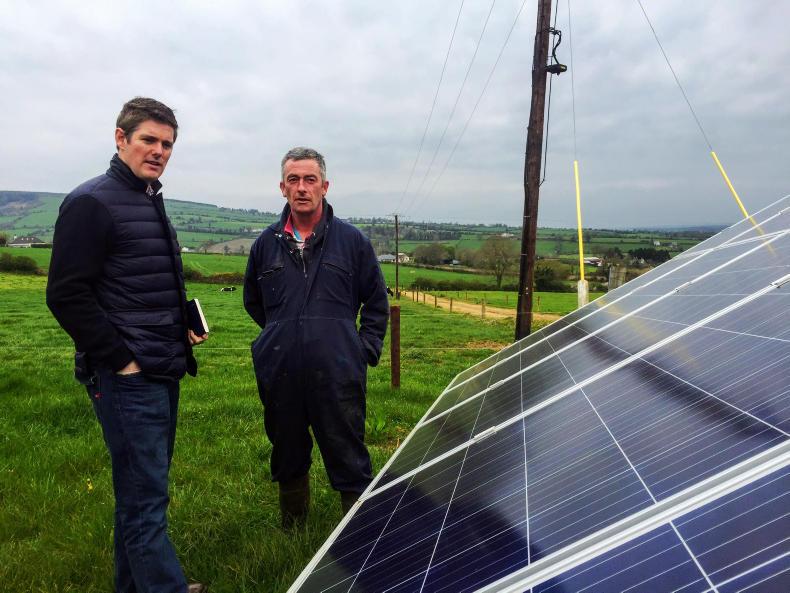
Michael Moore, development manager at Elgin Energy (left), and dairy farmer Cathal Moran on his farm in Skeoughvosteen, Co Kilkenny. \ Thomas Hubert
“We’d take a strong view on educating government and stakeholders on solar,” said Michael. He added that a dairy farm was a good case because grass growth, milking activity and production of solar electricity all increase together in the summer.
Meanwhile, Cathal says that dairy expansion since the end of quotas had been “fantastic,” but “what is coming at us is the environmental side and the social licence to farm”. This includes improving his carbon footprint: “We have to sell ourselves, put our best foot forward – not react to all those anti people,” he said. The other challenge for Cathal’s growing dairy farm is costs: “If you can replace your ESB bills, that’s a huge benefit,” he said.
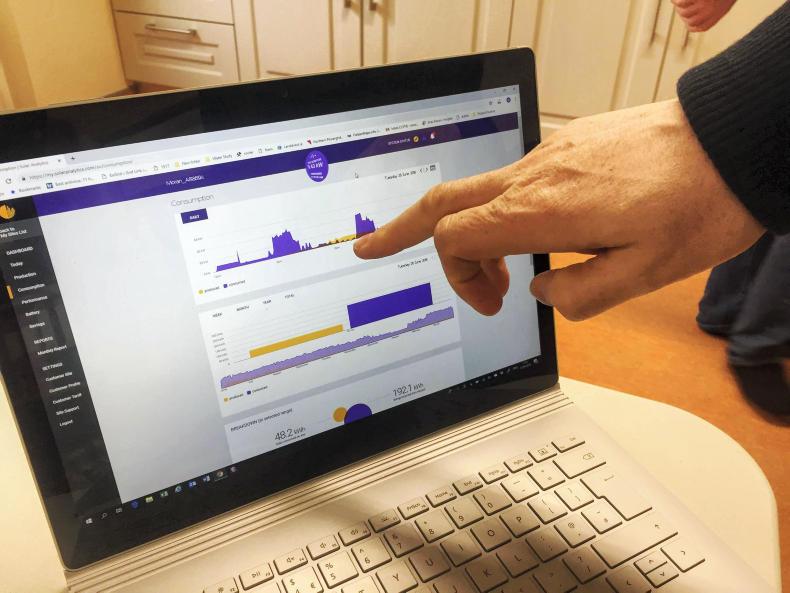
Online monitoring of the electricity produced by solar panels on the dairy farm of Cathal Moran in Skeoughvosteen, Co Kilkenny. \ Thomas Hubert
They contracted installers Activ8 to put in the two arrays of solar panels, with a capacity of 11 kilowatt potential (kWp), the inverter to control the electricity flow and a buried cable to the farm’s fuse board at a cost of €14,500. Because this is a demonstration project, it had to be at ground level for visitors to see it, so planning permission was required, which took three months. Otherwise, solar panels on shed roofs can be installed without planning permission under 50m2 or 50% of the roof area. Installation took one day, thanks to the tree system where anchors are drilled into grassland to secure the frames without pouring concrete foundations.
Uses
Cathal milks early in the morning between 5am and 6am, before solar power is generated. Water heaters are timed to come on later in the morning, once the sun is out.
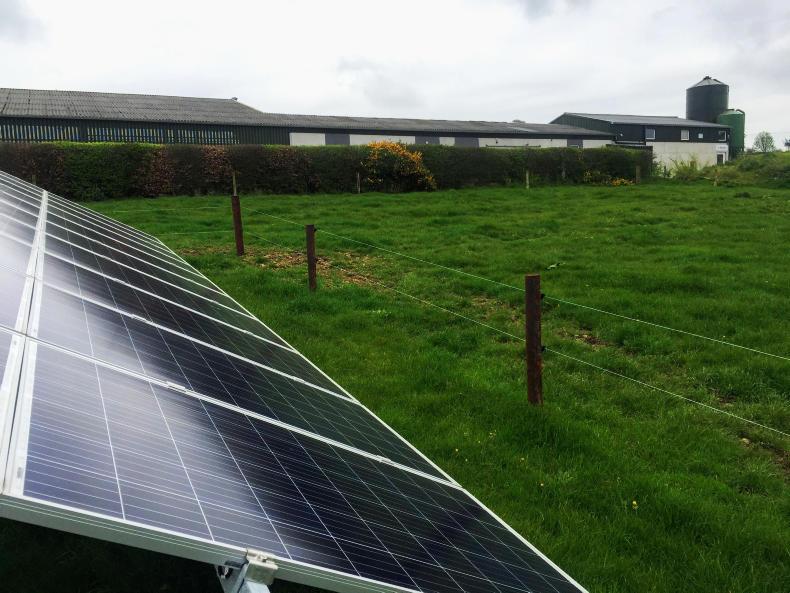
Solar panels on the dairy farm of Cathal Moran in Skeoughvosteen, Co Kilkenny. \ Thomas Hubert
This is not the best use of solar electricity, because water could be heated on the night rate when most grid electricity comes from renewable sources anyway. It’s the afternoon milking and cooling – from around 3pm – that makes the most from the solar panels. From July to December 2018, they produced 5,000kWh of electricity. The farm used 3,500kWh, representing 10% of its consumption and a €630 saving at the day rate of €0.18/kWh. The remaining 1,500kWh was exported to the grid, but there is currently no way of getting paid for it. In a full year, Cathal hopes to cancel out 15% of his electricity bills, and Elgin Energy estimates this could even rise to 20%. With a TAMS II grant, this installation would pay for itself in 9.2 years at the 40% rate or eight years at the 60% young farmer’s rate (see Table 1). Smaller installations would have a shorter payback time because the grants are capped to the size of a 6kWp system.
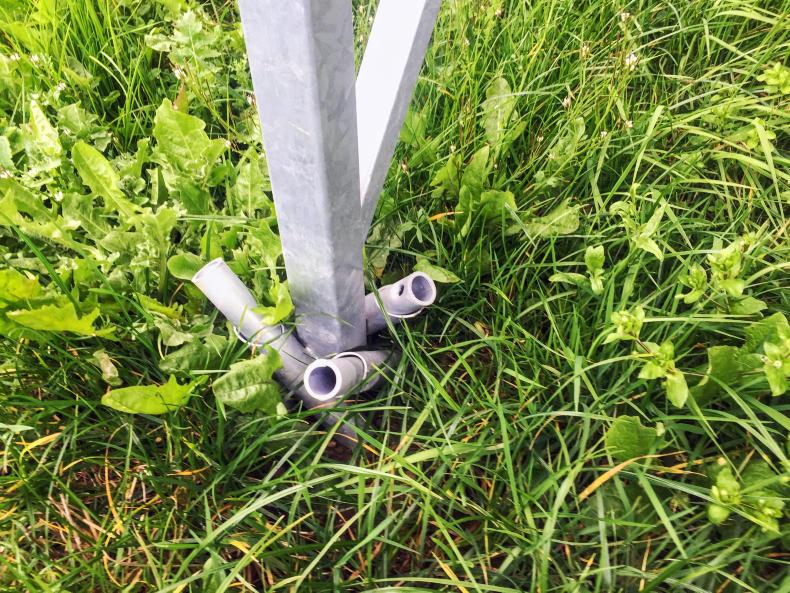
The Tree System anchors used to support solar panels on the dairy farm of Cathal Moran in Skeoughvosteen, Co Kilkenny. \ Thomas Hubert
The next logical step would be to put in batteries to store the excess energy when the sun shines strongest and use it for morning milkings, but Cathal has doubts about the environmental impact of battery manufacturing: “There’s no point in doing it half-way,” he said.
‘Pay me and I’ll do more’
Cathal would like to do more: “Ideally you’d have enough power to run the farm from solar,” he said.
To make this financially viable, he would need to get paid for the excess electricity he sends into the grid when it is not being used in the yard. “A new EU directive will facilitate this at a fair price,” said Michael, adding that wholesale prices currently fluctuate between 6c/kWh and 9.5c/kWh.
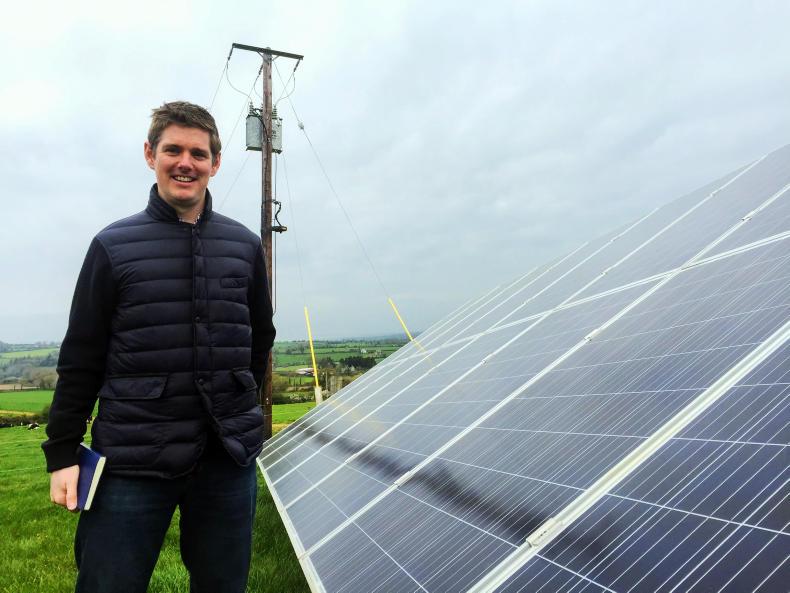
Michael Moore. \ Thomas Hubert
The Citizen’s Assembly on climate change also recommended this, and a bill is before the Oireachtas to speed up this process before the EU deadline of 2021.
Power demand is forecast to rise, and climate change legislation means more and more needs to come from renewable sources.
“This electricity is going to be produced anyway – by us in commercial farms,” said Michael. Elgin Energy has planning permission for 105MW of capacity across 21 projects totalling 525ac. “Instead of one big controversial farm, why not have it distributed to 100 local farms?”
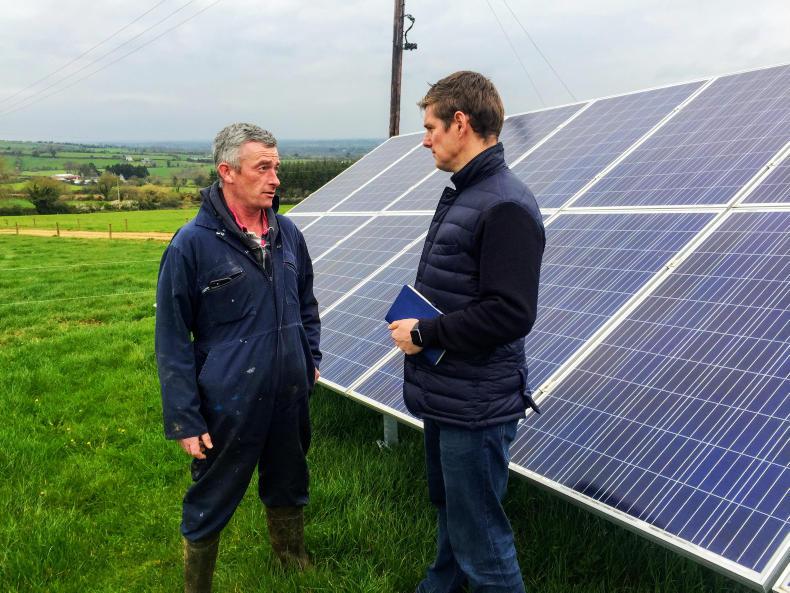
Dairy farmer Cathal Moran (left) and Michael Moore, development manager at Elgin Energy, on Cathal's farm in Skeoughvosteen, Co Kilkenny. \ Thomas Hubert
Cathal Moran’s 320 cows graze on his 176ha farm in Skeoughvosteen, Co Kilkenny – except for a small patch close to the yard, which he has fenced off to erect 40 solar photovoltaic (PV) panels. They produced 10% of the farm’s electricity needs in the second half of 2018.
Cathal met Michael Moore, a developer with the renewable company Elgin Energy, through mutual interest in solar. They decided to set up a demonstration project on the farm, with all costs paid for by Elgin Energy – there were no grants for this type of farm setup at the time.
Michael Moore, development manager at Elgin Energy (left), and dairy farmer Cathal Moran on his farm in Skeoughvosteen, Co Kilkenny. \ Thomas Hubert
“We’d take a strong view on educating government and stakeholders on solar,” said Michael. He added that a dairy farm was a good case because grass growth, milking activity and production of solar electricity all increase together in the summer.
Meanwhile, Cathal says that dairy expansion since the end of quotas had been “fantastic,” but “what is coming at us is the environmental side and the social licence to farm”. This includes improving his carbon footprint: “We have to sell ourselves, put our best foot forward – not react to all those anti people,” he said. The other challenge for Cathal’s growing dairy farm is costs: “If you can replace your ESB bills, that’s a huge benefit,” he said.

Online monitoring of the electricity produced by solar panels on the dairy farm of Cathal Moran in Skeoughvosteen, Co Kilkenny. \ Thomas Hubert
They contracted installers Activ8 to put in the two arrays of solar panels, with a capacity of 11 kilowatt potential (kWp), the inverter to control the electricity flow and a buried cable to the farm’s fuse board at a cost of €14,500. Because this is a demonstration project, it had to be at ground level for visitors to see it, so planning permission was required, which took three months. Otherwise, solar panels on shed roofs can be installed without planning permission under 50m2 or 50% of the roof area. Installation took one day, thanks to the tree system where anchors are drilled into grassland to secure the frames without pouring concrete foundations.
Uses
Cathal milks early in the morning between 5am and 6am, before solar power is generated. Water heaters are timed to come on later in the morning, once the sun is out.

Solar panels on the dairy farm of Cathal Moran in Skeoughvosteen, Co Kilkenny. \ Thomas Hubert
This is not the best use of solar electricity, because water could be heated on the night rate when most grid electricity comes from renewable sources anyway. It’s the afternoon milking and cooling – from around 3pm – that makes the most from the solar panels. From July to December 2018, they produced 5,000kWh of electricity. The farm used 3,500kWh, representing 10% of its consumption and a €630 saving at the day rate of €0.18/kWh. The remaining 1,500kWh was exported to the grid, but there is currently no way of getting paid for it. In a full year, Cathal hopes to cancel out 15% of his electricity bills, and Elgin Energy estimates this could even rise to 20%. With a TAMS II grant, this installation would pay for itself in 9.2 years at the 40% rate or eight years at the 60% young farmer’s rate (see Table 1). Smaller installations would have a shorter payback time because the grants are capped to the size of a 6kWp system.

The Tree System anchors used to support solar panels on the dairy farm of Cathal Moran in Skeoughvosteen, Co Kilkenny. \ Thomas Hubert
The next logical step would be to put in batteries to store the excess energy when the sun shines strongest and use it for morning milkings, but Cathal has doubts about the environmental impact of battery manufacturing: “There’s no point in doing it half-way,” he said.
‘Pay me and I’ll do more’
Cathal would like to do more: “Ideally you’d have enough power to run the farm from solar,” he said.
To make this financially viable, he would need to get paid for the excess electricity he sends into the grid when it is not being used in the yard. “A new EU directive will facilitate this at a fair price,” said Michael, adding that wholesale prices currently fluctuate between 6c/kWh and 9.5c/kWh.

Michael Moore. \ Thomas Hubert
The Citizen’s Assembly on climate change also recommended this, and a bill is before the Oireachtas to speed up this process before the EU deadline of 2021.
Power demand is forecast to rise, and climate change legislation means more and more needs to come from renewable sources.
“This electricity is going to be produced anyway – by us in commercial farms,” said Michael. Elgin Energy has planning permission for 105MW of capacity across 21 projects totalling 525ac. “Instead of one big controversial farm, why not have it distributed to 100 local farms?”

Dairy farmer Cathal Moran (left) and Michael Moore, development manager at Elgin Energy, on Cathal's farm in Skeoughvosteen, Co Kilkenny. \ Thomas Hubert







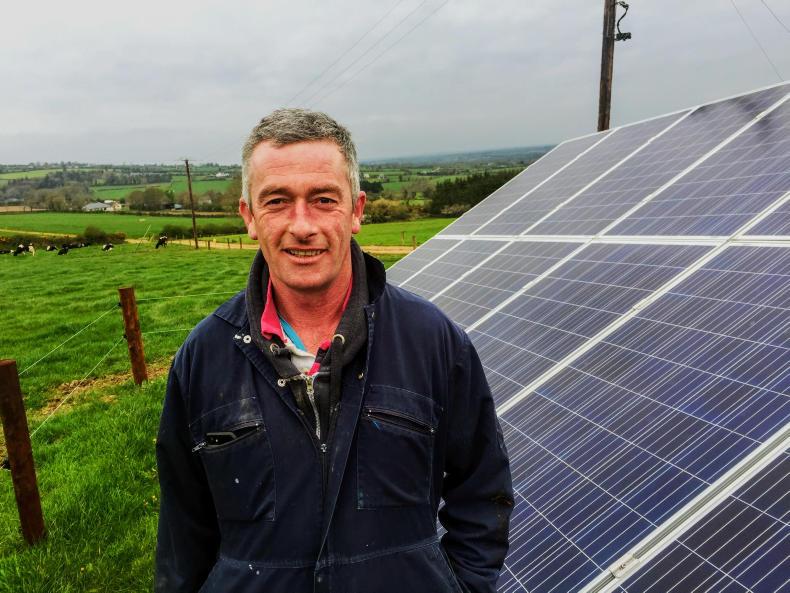




 This is a subscriber-only article
This is a subscriber-only article















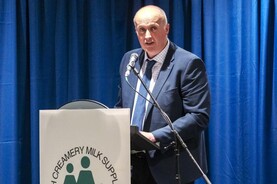

SHARING OPTIONS: